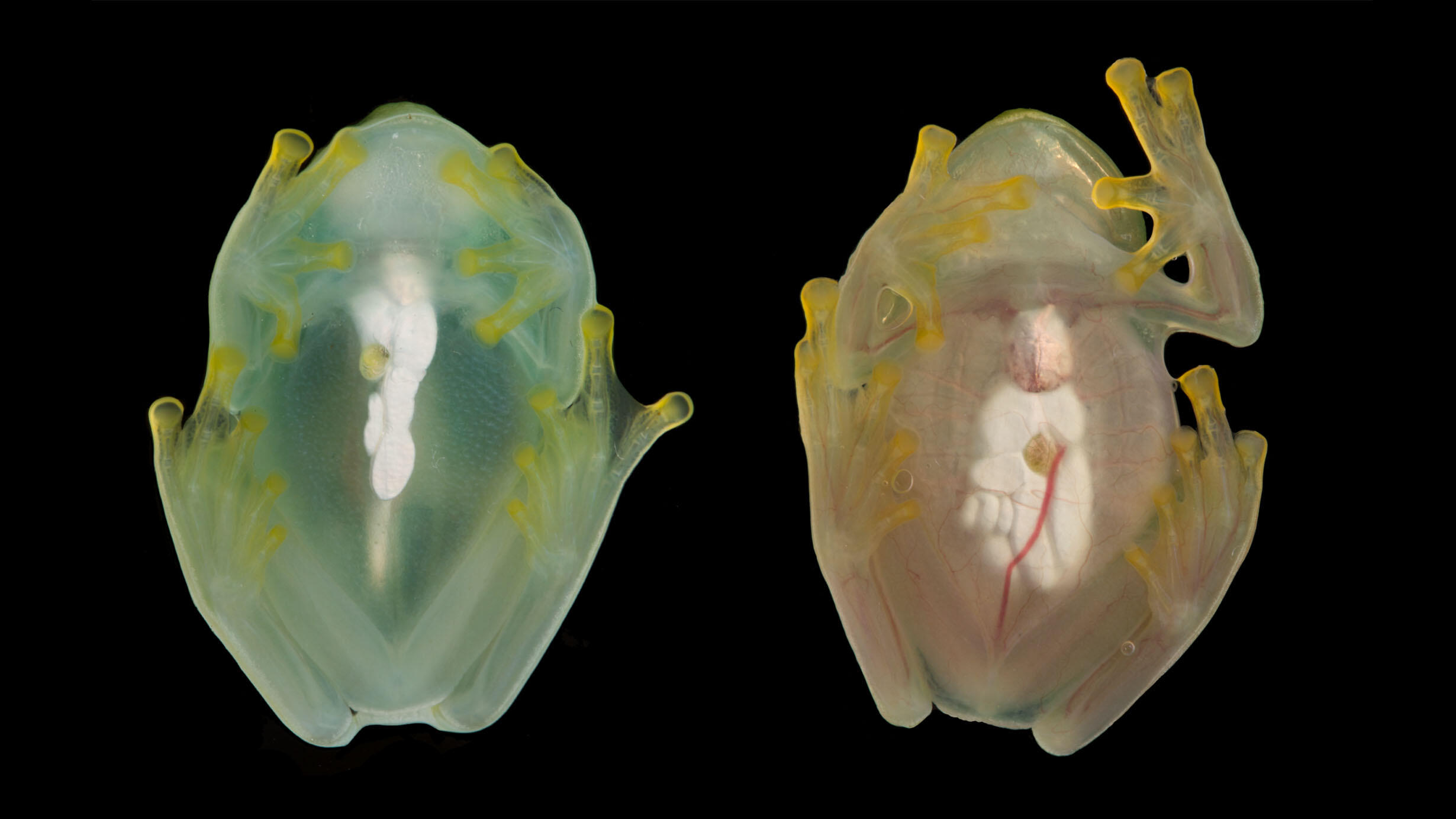Could frogs hold the secret to preventing blood clots in humans?
These tiny, transparent frogs clump their red blood cells together to blend into their surroundings — without ever forming deathly clots
Carrie Klein • March 14, 2024

Glassfrogs have evolved a unique adaptation that allows them to hide their red blood cells when asleep, making them virtually invisible to predators. A sleeping glassfrog (left) and a glassfrog after some activity (right). [Image Credit: Jesse Delia]
After a night spent stumbling along a stream in Panama with a flashlight, Jesse Delia finally spotted a glassfrog. It was 2018 and Delia was a doctoral student studying the transparency of glassfrogs’ skin, an extremely rare feature in animals found on land.
He caught the dime-sized frog and brought it back to his lab to photograph. But it was late and Delia was hungry. “I snuck out of the lab to get something to eat,” he told an audience during a talk at the American Museum of Natural History. When Delia came back, the frog had fallen asleep. And its red blood cells — normally visible through its skin — were gone.
“I couldn’t see the red blood cells anymore,” he said. “It didn’t make any sense. I thought I had injured the frog or it had bled out or something.”
As Delia later discovered, sleeping glassfrogs hide nearly 90% of their red blood cells inside their livers, concealing one of the sole sources of color in their bodies to make them extra protected from predators. His findings on how this works are now published in Science.
What most intrigued Delia was how the glassfrogs could clump blood cells together without forming life-threatening blood clots. Interestingly, the frogs can also form a clot when injured, to stop excessive bleeding.
In most cases, “packing red blood cells together is bad,” Delia put it. It can cause coagulation: when blood hardens, preventing its flow. Blood carries oxygen; if that oxygen can’t circulate throughout the body, most animals won’t survive.
But glassfrogs are apparently unaffected. While clumping their blood cells during sleep does reduce the amount of oxygen transported throughout their bodies, it doesn’t seem to harm them in any way, Delia explained.
When the frogs wake up and begin to move around, their red blood cells disperse once again into circulation, “so they can keep their tissues oxygenated and do frog stuff again,” Delia said.
In humans, blood clots lead to 1 in 4 deaths each year, globally. The most common treatment for clots is blood thinning medication, which comes with the risk of excessive bleeding.
Glassfrogs’ ability to clump blood cells without any drastic side effects “could be inherently an amphibian trick,” Delia said. On the other hand, “understanding this selective mechanism could help provide insight for blood cell research,” he added.
If glassfrogs’ unique trick does turn out to be applicable to humans, it could have potentially lifesaving impacts. And glassfrogs are a particularly good case study, as they share the same genetic factors that regulate blood flow in humans, Delia’s study notes.
Knowing how glassfrogs avoid clots “could have potential for us to understand more about blood clotting,” said Dr. William Lam, a researcher and professor of hematology and oncology at Emory University, “but a lot more studies need to be worked out.”
Lam is not only intrigued by the frogs’ ability to pool blood without deadly consequences, but also to move their blood cells around. Blood pooling, which can happen after staying still for long periods of time – like sitting for hours on an airplane – is one way blood clots can form. Learning how frogs transport their blood cells to their livers could be useful to eventually develop medicines that mimic this mechanism, preventing blood pooling in humans.
Delia and his team are in the process of collaborating with a blood clot lab at the University of North Carolina to launch research into understanding the mechanisms behind blood clotting. If they’re able to find how frogs stop clots and apply that to humans, Delia said, “there’s a million things we can do.”